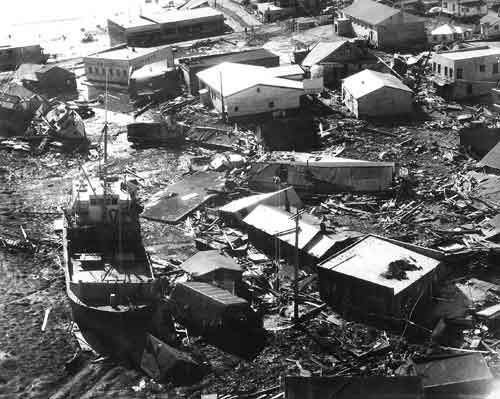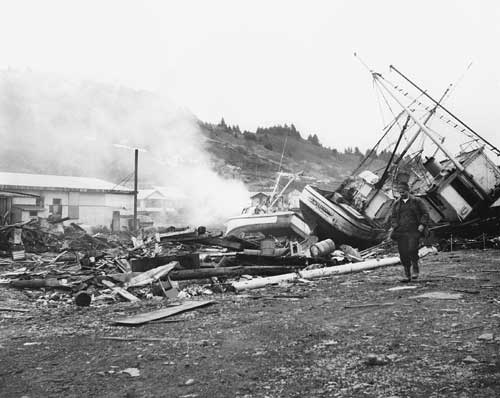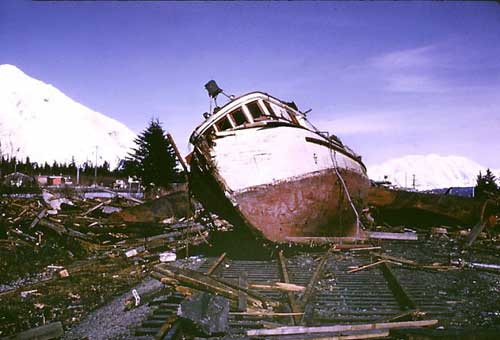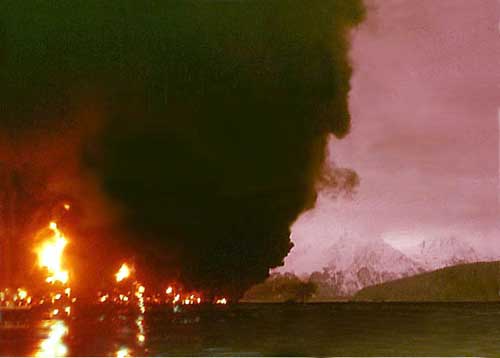 Alaska Killer Tsunamis Featured
on AlaskaOne Public Television
Alaska Killer Tsunamis Featured
on AlaskaOne Public Television
Describes tsunami warning
system and how coastal residents should react...
October 19, 2004
Tuesday
More than 100 Alaskans were swept to their deaths when multiple
tsunamis hit Alaska shores after the 1964 earthquake. The magnitude
9.2 temblor was the most powerful earthquake ever recorded in
North America. The tsunamis wiped out Valdez and destroyed much
of Seward, Kodiak, Whittier and other Alaska communities.
 Tsumani Damage in Kodiak
- 1964
Tsumani Damage in Kodiak
- 1964
Forty years after that terrible night, memories remain vivid
for sourdough Alaskans who witnessed the destruction. Some of
their impressions will be shared on Thursday, October 21 at 7:00
p.m. when Ocean Fury: Tsunamis in Alaska, a half-hour documentary,
airs statewide on AlaskaOne Public Television. The program will
be repeated on Sunday, October 24, at 2:00 p.m. The documentary
was co-produced by the Alaska Sea Grant College Program, the
UAF Geophysical Institute Alaska Earthquake Information Center,
and the Alaska Division of Homeland Security and Emergency Management.
Residents of Seward, Valdez,
and Kodiak begin the program with vivid eyewitness accounts of
what they saw when the black waves of March raked Alaska's shores
in 1964.
 Tsumani Damage in Kodiak
- 1964
Tsumani Damage in Kodiak
- 1964
Bob Eads of Seward describes how
he and his brother saw the first tsunami enter and circle around
Resurrection Bay as they tried and failed to outrun it in their
Ford pickup. Immersed in the wave and pummeled in darkness, Eads
tells how they realized they were about to die. But miraculously,
their truck held up and the wave deposited them far up-shore.
They kicked out the windshield and managed to escape what they
thought would be their coffin.
Doug McCrae of Seward describes
how he got his wife and baby onto the roof of their house just
as the tsunami struck, destroying the house next door and tearing
his house from its foundation, sending them on a "wild,
wild ride." He recalls being afraid that tree limbs were
going to scrape his family off the roof as his house careened
through the woods. Their nightmarish ride ended with the house
wedged between some cottonwood trees. Throughout the night, more
tsunamis swept through Resurrection Bay while McCrae and his
family stayed stranded in their pitch-black attic, soaked and
cold. They staved off a second brush with death, this time from
hypothermia in the freezing temperature, by wrapping themselves
in fiberglass insulation until McCrae could go for help the next
morning, slogging through slush, ice, and debris.
 Tsumani Damage in Seward
- 1964
Tsumani Damage in Seward
- 1964
Tom Gilson of Valdez describes
how he stood in horror and disbelief as the Valdez dock disintegrated
while visitors and workers on the dock frantically ran back and
forth trying to save themselves, finally disappearing into the
sea. All but one person died.
All the stories are not so
tragic. Ruth Brechan of Kodiak tells how she helplessly watched
as the tsunami surge carried a man in a small, spinning skiff
down the channel and out to sea. She assumed the man had perished.
A year later in a Kodiak bar while recounting what she had seen,
a man spoke up from across the room, saying "Ruthie, that
was me in that skiff!"
Patricia Williams of Seward
describes a moment of humor with her mother as they stood together,
looking out upon the tangled field of debris that used to be
the Seward waterfront. She said, "Well mom, there goes your
All-American City," and they laughed.
Kurt Byers, communications
manager at Alaska Sea Grant, conceived and led production of
the documentary. "The idea is to capture some of the thoughts
of the people who witnessed one of the world's most impressive
natural disasters. Most of us weren't here in 1964, so I wanted
to interview people who were here and saw the incredible force
of the tsunamis. Once I started contacting these people and listening
to their accounts, I knew we had a compelling story," Byers
said.

Aftermath of tsumani
in Seward - 1964
The producers also tapped the power of the Alaska Region Supercomputer
to help explain the physics of tsunamis. State-of-the art 3-D
video animations created by UAF art faculty member, Miho Aoki,
show what causes tsunamis and how they behave. The program also
describes Sea Grant and NOAA research at the UAF Institute of
Marine Science and the Earthquake Information Center at the Geophysical
Institute that is used to create maps that project where tsunamis
will flood towns under different conditions. In recent years,
officials in Seward and Kodiak used the maps to plan evacuation
routes and worked with the Alaska Division of Homeland Security
and Emergency Management to help win Tsunami-Ready designations
for those communities. Similar efforts are under way in other
Alaska towns.
The program also describes
how the tsunami warning system operates in Alaska from the NOAA
West Coast and Alaska Tsunami Warning Center in Palmer and points
out how coastal residents should react when an earthquake occurs.
"We want to drive home
the point that we need to be prepared for the next time tsunamis
hit Alaska. We also want to let people know how UAF and government
agencies are working together with state-of-the-art computer
technology to help save lives," Byers said.
Story and photographs courtesy:
University of Alaska - Alaska
Sea Grant Program
Web Site
E-mail your news &
photos to editor@sitnews.org
Publish A Letter on SitNews Read Letters/Opinions
Submit
A Letter to the Editor
Sitnews
Stories In The News
Ketchikan, Alaska
|




